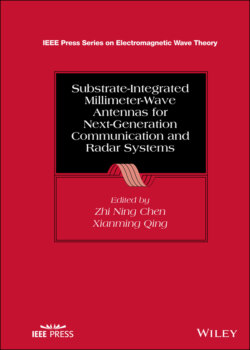Читать книгу Substrate-Integrated Millimeter-Wave Antennas for Next-Generation Communication and Radar Systems - Группа авторов - Страница 23
1.4 Unique Challenges of Millimeter Wave Antennas
ОглавлениеAn antenna is the only means to transfer the electric power from the circuits of a wireless system to a medium and vice versa. There have been many design challenges for conventional antennas such as wide operation bandwidth, high gain and radiation efficiency, desired radiation performance, small/compact size and conformal shapes, and low‐cost material utilization and fabrication. However, the design of antennas for mmW systems faces unique challenges because of its higher frequencies, or shorter wavelengths.
From the design point of view:
1 Wide Bandwidth: At mmW bands, usually we enjoy wide available spectra for wireless communications and radar applications. The typical operating bandwidth is more than 10% for both required impedance matching and desired radiation performance such as radiation patterns, radiation efficiency, and polarization. It is indeed challenging for the antennas to meet all design requirements simultaneously.
2 High Gain: Due to high operating frequencies, the path‐loss in propagation at mmW bands, in particular in rainy, foggy, or snowy weather, becomes much more critical than that at microwave bands. To compensate for the high path‐loss, we must design antennas with much higher gain. For example, the gain of the antennas should reach up to 15 dBi for 10 m LOS wireless links at 60 GHz bands for some systems under the IEEE 802.11ad standard.
3 High Radiation Efficiency: Due to high operating frequencies, the ohmic losses caused by materials and connections in the design become severe. Usually, the loss of the dielectric and metals increase against frequencies. For instance, FR4 has loss tangents of 0.016 at 1 MHz and > 0.1 at 16 GHz, respectively. The other loss can be caused by surface waves due to electrically thick dielectric used in antenna design. For instance, the dielectric substrate of a patch antenna increases its electrical thickness from a typical 0.01 operating wavelength at a frequency of 2.4 GHz to 0.1 wavelength at 24 GHz if the same dielectric substrate is used for the patch antenna design. The thicker substrate inevitably causes severer surface waves. The increased surface waves guide part of the radiated power to other directions rather than the desired direction, for instance, boresight. Such loss lowers the radiation efficiency or gain of the antenna.
4 Beam‐Scanning Functionality: Due to the need of high gain, the beamwidth of the radiation pattern is narrow so that it is difficult to achieve a wide coverage, but it is easy for the radiation to be blocked by unwanted obstacles. To keep propagation links unbroken, the functionality of beam‐scanning of antennas is one solution. Therefore, much more expensive and complicated antenna designs are necessary.
From the fabrication and measurement point of view:
1 High‐End Material and Tight Tolerance Fabrication: To keep low the ohmic loss caused in materials, high‐end materials, usually at higher prices, must be used. For instance, FR4 is replaced by more expensive but higher performance Rogers or ceramic or liquid crystal polymer (LCP). Meanwhile, due to the shorter wavelengths at higher frequencies, higher‐precision fabrication processes are needed to achieve results within the acceptable tolerance. For example, conventional printed circuit board (PCB) process can guarantee a tolerance of 0.2 mm, which is 0.2% wavelength at 3 GHz but 4% wavelength at 60 GHz!
2 Testing Setup: There have been many antenna testing setups up to 40 GHz in the market and laboratories. It is necessary to upgrade the setups and system for the antenna test for the frequencies higher than 40 or 67 GHz. Expensive frequency up‐converter heads are necessary for the frequency extension of such mmW systems. For the measurement of impedance or S‐parameters, high‐quality but expensive connectors and cables must be used to keep the insertion loss acceptable. In addition, the on‐wafer mmW antenna measurement must be carried out using precise and expensive probes where the measurement is usually conducted on expensive specific probe stations. For the measurement of radiation performance, due to the lack of link budget and the concern of testing environments, it is necessary to design the setup by customizing the mechanical structures with high‐precision location and orientation.
In short, the design of mmW antennas faces much more lossy, complicated, and costly issues than those at lower microwave frequencies. The research and development activities of mmW antenna technology should be done by taking all such unique challenges into account.
